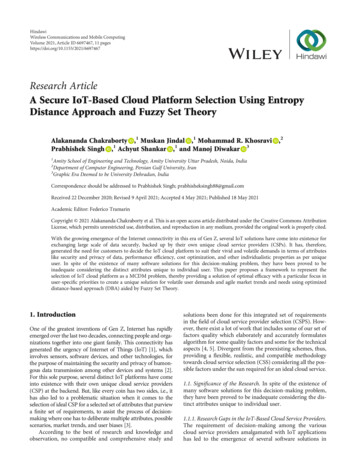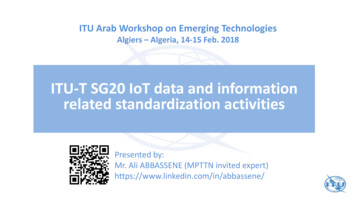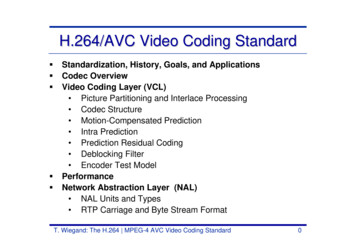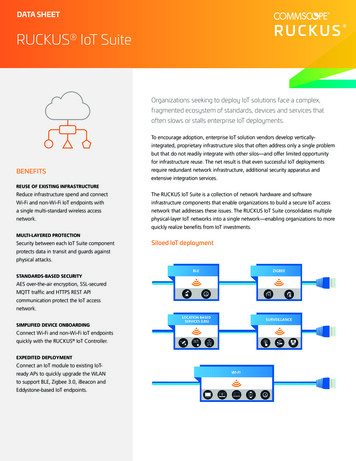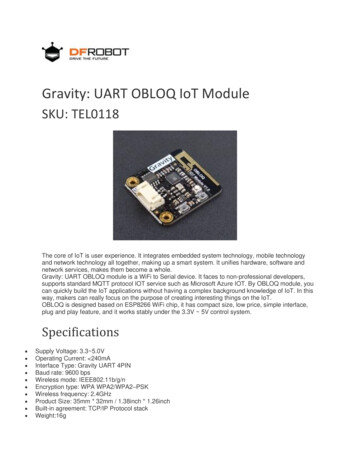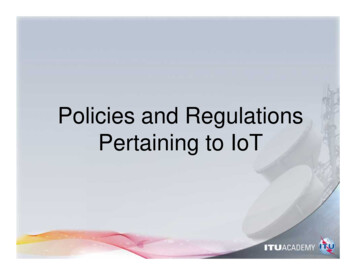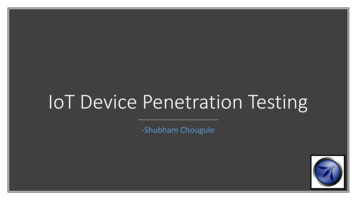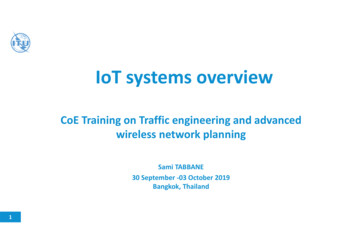
Transcription
IoT systems overviewCoE Training on Traffic engineering and advancedwireless network planningSami TABBANE30 September -03 October 2019Bangkok, Thailand1
Objectives Present the different IoT systemsand their classifications2
SummaryI. IntroductionII. IoT TechnologiesA. Fixed & Short RangeB. Long Range technologies1.Non 3GPP Standards (LPWAN)2.3GPP Standards
IoT Specificities versus CellularIoT communications are or should be: Low cost, Low power, Long battery duration, High number of connections, Low bitrate, Long range, Low processing capacity, Low storage capacity, Small size devices, Relaxed latency, Simple network architecture and protocols.
IoT Main Characteristics Low power, Low cost (network and end devices), Short range (first type of technologies) or Longrange (second type of technologies), Low bit rate ( broadband!), Long battery duration (years), Located in any area (deep indoor, desert, urbanareas, moving vehicles )
Low cost3GPP Rel.8CostCAT-475% 3GPP Rel.820% 3GPP Rel.13CAT-110% 3GPP Rel.13CAT-M1NBIoTComplexity
Extended coverage 20dB 15 dBGPRSCAT-M1NB-IoT
IoT Specificities
IoT Specificities and Impacts on Network planning and designCharacteristicsImpactLow power andWide Range High sensitivity (Gateways and end-devices with a typical sensitivityaround -150 dBm/-125 dBm with Bluetooth/-95 dBm in 2G/3G/4G) Low frequencies strong signal penetration Narrow band carriers far greater range of reception 14 dBm (ETSI in Europe) with the exception of the G3 band with 27 dBm, 30 dBm but for most devices 20 dBm is sufficient (USA)Low deploymentand OperationalCosts Low gateways cost Wide range Extended coverage strong signal penetration(deep indoor, Rural) Low numbers of gateways Link budget: UL: 155 dB (or better),DL: Link budget: 153 dB (or better) Long Battery life (10mA RXcurrent, 100nA sleep current) Low PowerIdle mode most of the time.Connected mode just for transmission (some mA) 100 MHz clock frequencyEmbedded memory of a few MoIdle mode allowing an energy consumption of around 100 µWN.B.: planning tasks only apply to long range9 technologies (type 2).
IoT Specificities and Impacts on Network planningCharacteristicsShared Spectrum Interference ManagementService diversityImpact-Clear channel assessmentFrequency hoppingOFDM/CDMA access and NOMA technologiesActivity rate around 1% (regulation and energyconstraints)- Diversity of the traffic models- Diversity of the transmission modesLow bitrates (hundreds to thousandsof bits/sec. compared to 250 Kbit/s in - Low capacity and lower number of gatewaysZigBee and 1-2 Mbit/s in Bluetooth)Small payloads (around 1000 bits):encrypted device ID andmeasurement or actuation commandSimple topology (single-hop links)- Low capacity and lower number of gateways- Simplifies the coverage of large areas- Share the existing cellular networksinfrastructureIoT Networks and Services are Very Different from « Classical Networks »in Many Aspects and Especially from a Planning Perspective
Tools and Techniques to Meet the Goals Communicate with Low Cost andLow Power Repetition Communicate in a Shared Bandwidth Spread Spectrum Low ActivityRate Communicate in Wide Areas LowSensitivity
IoT componentsIdentification RFID Bar codes AND SensorsConnectionIntegration Temperature Hydrometer Accelerometer Gyro meter Nanotechnologies Bluetooth ZigBee Z-Wave WiFi Sigfox LoRa NB-IoT Simplemiddleware Decisionalanalysis ofcomplexsystemsDataprocessing Databases ERP CRM 3D datawarehouse SemanticWeb andontologiesNetworks Internet EPC
IoT generated value IoT is a system to collect, store, process,manage, analyze, information and datafrom almost any object. Value is not in the network (collection andconnectivity) but it is in the data itself. IoT is an opportunity for countries andpeople to better have a control of their dataand especially, give value to localinformation and data.
SummaryI. IntroductionII. IoT TechnologiesA. Fixed & Short RangeB. Long Range technologies1.Non 3GPP Standards (LPWAN)2.3GPP Standards
II.IoT Technologies
IoT wireless technologies overview
IoT 4 layers tworkInfrastructureSensing andIdentification
IoT network general architectureCloud StorageIntelligence and AnalyticsSatelliteCable fiberCellularIndustry GTWSensors, actuatorsConsumer GTW
Things classification Things/Objects differentiate according to: The range (short, medium, long) The type of interaction with the system (i.e.,service type):End deviceNetworkEnd deviceNetwork Alarm (transmission initiated by theend-device only, according to theevents, bursty traffic), Measurements (triggered either bythe end-device or by the system),End deviceNetwork Control (transmissions initiated bythe system),End deviceNetwork Combination of these.
Things states and operationsThe device can: Publish or Subscribe Be online or offline Manage messages of different formats Have different types of communicationchannels Have one channel or several datastreams
Quiz 1 – IoT networks architecture1. What are the main features of an IoT system?2. What are the 4 layers of an IoT network?3. What are the main components of an IoT network?4. What are the different types of objects in IoT?5. What are the operations an object (i.e., end-device) canachieve?6. What kinds of IoT networks can be distinguished?21
SummaryA. Fixed & Short RangeB. Long Rangetechnologies1.Non 3GPP Standards (LPWAN)2.3GPP Standards
A. Fixed & Short Rangei.RFIDii. Bluetoothiii. Zigbeeiv. WiFi
i.RFID
RFID (Radio Frequency Identification) Appeared first in 1945 Features: Identify objects, record metadata or control individualtarget More complex devices (e.g., readers, interrogators, beacons)usually connected to a host computer or network Radio frequencies from 100 kHz to 10 GHz Operating: reading device called a reader, and one or more tagsRFID Frequencies
RFIDHow does it work?Tag Microchip connected to an antenna Can be attached to an object as his identifierReader RFID reader communicating with the RFID tagthrough radio waves
RFIDDifferent Types of TAGsPassive TagsActive TagsPowerPowering through RF fromInternal to the TagReaderBatteryNoYesAvailabilityOnly in the field of RadarContinuousRequired Signal Strength to Tag Very HighVery LowRangeUp to 3-5mUp to 100mMulti Tag ReadingFew Hundred within 3meters from the reader1000’s of tags recognizedData Storage128 bytes128 bytes with searchand accessShort or very short range technology, most applications are based onmanual involvement and limited to presence detection.
ii.Bluetooth
Bluetooth characteristics Low Power wireless technology Short range radio frequency at 2.4 GHz ISM Band Wireless alternative to wires Creating PANs (Personal area networks) Support Data Rate of 1 Mb/s (data traffic, video traffic) Uses frequency-hopping spread spectrumClassMaximum PowerRange1100 mW (20 dBm) 100 m22,5 mW (4 dBm) 10 m31 mW (0 dBm) 1 m
Bluetooth characteristicsBluetooth Piconet Created instantly and automatically between Bluetooth devices within thesame area A master device and others slaves Slaves cannot directly send data to each others All traffic must go through the master Up to 7 active slavesBluetooth Scatternets Two or more piconets Devices that participate in twopiconet act as gateways
Bluetooth and IoTBluetooth Low Energy Enables IoT features Lowest cost and Easy to implement Improvements for ease of discovery & connection Low latency, fast transaction (3 ms from start to finish) Data Rate 1 Mb/s: sending just small data packets Bluetooth 5: 4x range, 2x speed and 8x broadcasting message capacity.Range 150 mOutput Power 10mW(10 dBm)Max current15 mAModulationGFSK at 2.4 GHzSleep current 1 µALow cost, available, ready to go.
iii. ZigBee
ZigBeeControl and wirelesssensor networkBased on the IEEE802.15.4 StandardCreated by the ZigbeeallianceOperates on unlicensed bands:Low data rates andlow powerconsumptionSmall packetnetworks- ISM 2.4 GHz at 250 Kbps- 868 MHz at 20 Kbps- 915 MHz at 40 KbpsTopology:Star, Cluster Tree,MeshUp to 65 000 nodeson a network
ZigBee Coordinator: acts as a root and bridge of the network Router: intermediary device that permit data to pass to and through themto other devices End Device: limited functionality to communicate with the parent nodesLow cost, available, ready to go.
iv. WiFi
WiFi Wireless technology Alternative to Wired Technologies IEEE 802.11 standard for WLANsStandardFrequency bandsThroughputRangeWiFi a (802.11a)5 GHz54 Mbit/s10 mWiFi B (802.11b)2.4 GHz11 Mbit/s140 mWiFi G (802.11g)2.4 GHz54 Mbit/s140 mWiFi N (802.11n)2.4 GHz / 5 GHz450 Mbit/s250 mIEEE 802.11ah900 MHz8 Mbit/s1000 m
Wi-Fi HaLow A new low-power, long-range version of Wi-Fi that bolsters IoT connections, itwill be available in 2018 Wi-Fi HaLow is based on the IEEE 802.11ah specification Data rates 100 kbit/s Wi-Fi HaLow will operate in the unlicensed wireless spectrum in the 900MHz band MAC is designed to support thousands of connected devices It will easily penetrate walls and barriers thanks to the propagation capabilities of lowfrequency radio waves. Its range will be nearly double today's available Wi-Fi (1 kilometer) Power Saving mode allows objects to remain inactive during max idle period after which, the STA is disassociated 5 yearssleeping! WiFi is longer range than Bluetooth and ZigBee More flexible Closer to networks
WiFi-based IoT Devices
Long Range TechnologiesNon 3GPP 93GPP Standards445GECEC-GSMNBNB-IOT
Wide-area M2M technologies and IoT40H. S. Dhillon et al., “Wide-Area Wireless Communication Challenges for the Internet of Things,” IEEE Communications Magazine, February 2017
Quiz 2 – Short range IoT systems1.What are the main 2 technologies used for IoT short range?2. What are the main changes introduced in existing shortrange system to allow IoT communications?3.What are the main advantage of using existing systems?4. What are the offered bitrates with these systems?5. What are the maximum ranges these systems canoffer?41
SummaryA. Fixed & Short RangeB. Long Range technologies1.Non 3GPP Standards (LPWAN)2.3GPP Standards
B. Non 3GPP Standards (LPWAN)i.LoRaWANii. Sigfoxiii. RPMAiv. Others43
LPWAN RequirementsLong batterylifeSupport for amassivenumber ofdevicesLow devicecostLPWANExtendedcoverage (10-15km in rural areas,2-5 km in urbanareas)44Low cost andeasydeployment
i.45LoRaWAN
RoadmapJun 2015By the end of2016All France territory covered byLoRaWAN network:Bouygues TelecomAmsterdam become the first city2013Creation of covered by the LoRaWANLoRa alliance networkSemtech develop LoRaWAN network20152010Cycleo developed LoRa technologyDifferences between LoRa and LoRaWAN46 LoRa contains only the link layer protocol. LoRa modules are a little cheaper that theLoRaWAN ones. LoRaWAN includes the network layer too so it is possible to send the information to anyBase Station already connected to a Cloud platform. LoRaWAN modules may work indifferent frequencies by just connecting the right antenna to its socket.
LoRa AllianceInternationalOperatorsIntegrators opment ofthe solutionAppropriatetechnology andmaintain it overtimeBroadcast 7Integrate LoRatechnology
LoRa technology Overview LoRaWAN is a Low Power Wide Area Network LoRa modulation: a version of Chirp Spread Spectrum (CSS) with a typicalchannel bandwidth of 125KHz High Sensitivity (End Nodes: Up to -137 dBm, Gateways: up to -142 dBm) Long range communication (up to 15 Km) Strong indoor penetration: With High Spreading Factor, Up to 20dBpenetration (deep indoor) Occupies the entire bandwidth of the channel to broadcast a signal, making itrobust to channel noise. 48Resistant to Doppler effect, multi-path and signal weakening.
ArchitectureModulationLoRa RF (SpreadSpectrum)Range 15 KmThroughput0.3 to 27 KbpsEnd DeviceEnd DeviceCloudLoRaGatewayEmailEnd DeviceLoRaGatewayNetworkServerTCP/IP SSLApplicationServerCustomer ITEnd Device49Type of TrafficData packetPayload 243 BytesSecurityAES EncryptionRemoteMonitoring
Spread spectrum basics50
Spectrumo Orthogonal sequences: 2 messages, transmitted by 2 different objects, arrivingsimultaneously on a GW without interference between them (Code DivisionMultiple Access technique: CDMA , used also in 3G).o Spread Spectrum: Make the signal more robust , the more the signal is spread themore robust. Less sensitive to interference and selective frequency fadings .AmplitudeGain when recovering theinitial signalSF 12: High gain, low data rateFar devices and deep indoorSF 9: Average gain, averagedata rateSF 7: Low gain , high datarate"Spread" signal transmittedwith constant rateFrequency51Spectrum: unlicensed, i.e. the 915 MHz ISM band in the US, 868 MHz in Europe
Spectrum (Influence of the Spreading Factor)Far with obstacles: High sensitivity required The network increases the SF (Spreading Factor) Throughput decreases but the connection is maintainedClose: Low sensitivity sufficient Decrease of SF (SPREADING FACTOR), increase of throughputAdaptive throughputADR: Adaptive Data Rate52
RSSI and SF versus BW53
SF, bitrate, sensitivity and SNR for a 125 kHz channelSpreading factorBitrate (bit/sec)Sensitivity (dBm)LoRa demodulator SNR7 (128)5 469-124 dBm-7.5 dB8 (256)3 125-127 dBm-10 dB9 (512)1 758-130 dBm-12.5 dB10 (1024)977-133 dBm-15 dB11 (2048)537-135 dBm-17.5 dB12 (4096)293-137 dBm-20 dBSF and repetition can be either manual (i.e., determined by the end-device) or automatic(i.e., managed by the network)54
LoRaWAN: device classesClassesA(« all »)B(« beacon »)C(« continuous »)DescriptionListens only afterend devicetransmissionIntended UseConsumptionModules with nolatency constraintThe most economiccommunication Classenergetically.Supported by all modules.Adapted to battery poweredmodulesModules with latencyThe modulelistensDescriptionconstraints for theat a regularlyreception ofadjustablemessages of a fewfrequencysecondsModule alwayslisteningModules with astrong receptionlatency constraint(less than onesecond) Fire Detection Earthquake EarlyDetectionConsumption optimized.Adapted to battery poweredmodules Smart metering Temperature rise Adapted to modules on the gridor with no power constraints Any LoRa object can transmit and receive data55Examples of ServicesFleet managementReal Time TrafficManagement
Class AOpen 2 windows for DLreception(acknowledgments, MACcommands, applicationcommands.) aftersending a packetGatewayEnd PointOne packet sentListening period: varies according to the spreading factor SF1 sec /- 20 us1st receive windowRX1Listening period 5.1 ms at SF7 (outdoor and close devices) 10.2 ms at SF8 164 ms at SF12 (deep-indoor or far devices)1 sec /- 20 us2nd56receive windowRX2Listening period Very economic energetically Communication triggered by theend device
Class B (Synchronized mode)GatewayEnd Point Synchronized with the GTW Opens listening windows atBeginning tagregular intervals.Rx1Listening durationListening duration: varies according to the SFOpens N reception windowsbetween the two tagsRx2Listening durationRx3Listening durationRxNListening durationEnd tag57 Optimized energy consumption Communication initiated by theGTW
Class C- Permanent listening- Closes the reception windowonly during transmissionsGatewayEnd PointPacket reception: possibleReception window alwaysopenClosed receive windowReception window is open58TXPacket transmissionPacket reception: possibleAdapted to devices onthe power grid
Identification of an end device in LORA End-device address (DevAddr):Network identifier7 bitsnetwork address of the end-device25 bits Application identifier (AppEUI): A global application ID in the IEEE EUI64 address spacethat uniquely identifies the owner of the end-device. Network session key (NwkSKey): A key used by the network server and the end-deviceto calculate and verify the message integrity code of all data messages to ensure dataintegrity. Application session key (AppSKey): A key used by the network server and end-device toencrypt and decrypt the payload field of data messages.59
Current state60
ii.61Sigfox
Roadmap6220122013Launch of theSigfoxnetworkFirst fundraisingof Sigfoxcompany tocover France2014Mars2016By the end of2016All Franceterritory iscovered bySigfox networkSan-Franciscobecome the firstUS. State coveredby SigfoxSigfox inAmerica in100 U.S.cities
Sigfox Overview First LPWAN Technology The physical layer based on an Ultra-Narrow bandwireless modulation Proprietary system Low throughput ( 100 bps) Low power Extended range (up to 50 km) 140 messages/day/device Subscription-based model Cloud platform with Sigfox –defined API forserver access Roaming capability63
ArchitectureFrequency BandUltra Narrow BandRange 13 KmThroughput 100 bpsEnd DeviceEnd DeviceCloudSigfoxGatewayEmailEnd DeviceSigfoxGatewayNetworkServerTCP/IP SSLNetworkServerCustomer ITEnd Device64Type of TrafficData packetPayload 12 BytesSecurityNo securityTime on airUp to 6 secondsRemoteMonitoringBy default, data is conveyed over the air interface without any encryption. Sigfox givescustomers the option to either implement their own end-to-end encryption solutions.
Spectrum and access Narrowband technology Standard radio transmission method: binary phase-shift keying (BPSK) Takes very narrow parts of spectrum and changes the phase of the carrierradio wave to encode the dataFrequency spectrum: 868 MHz in Europe 915 MHz in USA65
Sigfox transmission Starts by an UL transmission Each message is transmitted 3 times A DL message can be sent (option) Maximum payload of UL messages 12 data bytes Maximum payload of DL messages 8 bytesITU ASP RO66
Current state67
iii. RPMA68
Roadmap2008RPMA wasdevelopedby On-RampWireless to provideconnectivity to oiland gasactors69September2015it was renamedIngenu, andtargets to extendits technology tothe IoT and M2Mmarket2016RPMA wasimplemented in manyplacesAustin, Dallas/Ft.worth,Hostton,TX,Phenix,AZ, .2017RPMA will beinvaded in manyothers countries: LosAngeles, SanFranscisco-WestBay,CA,Washington,DC, Baltimore,MD,Kanasas City
INGENU RPMA overview Random Phase Multiple Access (RPMA)technology is a low-power, wide-areachannel access method used exclusivelyfor machine-to-machine (M2M)communication RPMA uses the 2.4 GHz band Offer extreme coverage High capacity Allow handover (channel change) Excellent link capacity70
INGENU RPMA Overview RPMA is a Direct Sequence Spread Spectrum (DSSS) using: Convolutional channel coding, gold codes for spreading 1 MHz bandwidth Using TDD frame with power control: Closed Loop Power Control: the access point/base station measures theuplink received power and periodically sends a one bit indication for theendpoint to turn up transmit power (1) or turn down power (0). Open Loop Power Control: the endpoint measures the downlink receivedpower and uses that to determine the uplink transmit power without .TDD frame71
Specifications of RPMA Solution Time/Frequency Synchronization Uplink Power Control Creating a very tightly power controlled system in free-spectrum and presence ofinterference which reduces the amount of required endpoint transmit power by afactor of 50,000 and mitigates the near-far effect. Frame structure to allow continuous channel tracking. Adaptive spreading factor on uplink to optimize battery consumption. Handover Configurable gold codes per access point to eliminate ambiguity of link communication. Frequency reuse of 3 to eliminate any inter-cell interference degradation. Background scan with handover to allow continuous selection of the best access point72
Specifications of RPMA Solution Downlink Data Rate Optimization Very high downlink capacity by use of adaptive downlinkspreading factors. Open loop forward error correction for extremely reliablefirmware download. Open loop forward error correction to optimize ARQ signaling.Signaling only needs to indicate completion, not which particularPDUs are lost.73
RPMA a Random multiple access Network74 Random multiple access is performed by delaying the signal to transmit ateach end-device Support up to 1000 end devices simultaneously For the uplink, or the downlink broadcast transmission, a unique Goldcode is used. For unicast downlink transmission, the Gold code is built with the enddevice ID, such that no other end-device is able to decode the data.
INGENU RPMA architectureFrequency Band2.4 GHZRange5-6 KmThroughput624 kb/s (UL) and 156 kb/s (DL)Access PointCloudBackhaul(Ethernet,3G, WiFi,.)Access PointEmailNetworkServerTCP/IP SSLNetworkServerCustomer ITEnd Device75Type of TrafficData packetPayload 16 Bytes (one end point) 1600 Bytes (for1000 end pointsSecurityAES EncryptionRemoteMonitoring
Uplink Subslot Structure Uplink Subslot Structure Supporting Flexible Data RateStep 1: Choose Spreading factor from 512 to 8192Step 2: randomly select subslotStep 3: Randomly select delay to add to subslot start from 0 to 2048 chips76
How end point can transfer a data?Access PointEnd PointRegistration request (how often the EP will communicate)Assigned a bit on the BCH channel (enable to send or No)Send the message (payload 16 bytes)AP response ( Ack or NACK): Successful transactionNot OK send againSend the messageSend Acknowledge77
RPMA security78Messageconfidentiality: use ofpowerful encryptionMessage integrity1Replay protectionMutualAuthenticationDevice AnonymityAuthentic firmwareUpgradesSecure Multicasts
RPMA’s current and future presence201779 Presence in Texas, with networks in Dallas, Austin, San Antonio, Houston, and large whitespace areas. Ingenu offer the connectivity to more 50% of the Texas state population. Three densely populated Texas markets are served by only 27 RPMA access points RPMA currently provides more than 100,000 square miles of wireless coverage for a host ofIoT applications.
RPMA’s current and future presenceCurrently live Austin,TX Dallas/Ft.worth,TX Hostton,TX Phenix,AZ Riverside,CA San Antonio,TX San Diego,CA80Coverage RolloutQ3 Columbus, OH Indianapolis,INCoverage ROLLOUTQ4 2016 Atlanta,GAJacksonville,FLMiami,FLOriando,FLNew le,TN ELpaso,TX Salt Lake City,UT Richmound, Virginiabeach,VACoverage planned2017 Los Angeles,CA San FransciscoWest Bay,CA Washington,DC Baltimore,MD Kanasas City Greeensboro,NC Las Vegas,NV Oklahorma City,OK And many morecities
v. Others81
EnOcean Based on miniaturized power converters Ultra low power radio technology Frequencies: 868 MHz for Europe and 315 MHz for the USA Power from pressure on a switch or by photovoltaic cell These power sources are sufficient to power each module to transmitwireless and battery-free information. EnOcean Alliance in 2014 more than 300 members (Texas, Leviton,Osram, Sauter, Somfy, Wago, Yamaha .)82
EnOceanArchitecture83
ZWave Low power radio protocol Home automation (lighting, heating, .) applications Low-throughput: 9 and 40 kbps Battery-operated or electrically powered Frequency range: 868 MHz in Europe, 908 MHz in the US Range: about 50 m (more outdoor, less indoor) Mesh architecture possible to increase the coverage Access method type CSMA / CA Z-Wave Alliance: more than 100 manufacturers in84
ZWaveServices85
Quiz 3 – LPWAN1.What are the main 2 IoT non-3GPP networks?2.What are the main characteristics of LPWAN?3.What are the 3 classes defined in LoRaWAN?4.What is the particular SigFox model proposed for the users?5.How many times a SigFox message is transmitted?6.What multiple access technique is used in LoRa and SigFox?7.What is the advantage of this multiple access technique inLPWAN communications?86
Thank you!87
IoT generated value IoT is a system to collect, store, process, manage, analyze, information and data from almost any object. Value is not in the network (collection and connectivity) but it is in the data itself. IoT is an opportunity for countries and people to better have a control of their data and especially, give value to .
